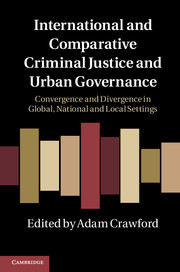 International and Comparative Criminal Justice and Urban Governance
International and Comparative Criminal Justice and Urban Governance from PART 2 - Comparative penal policies
Published online by Cambridge University Press: 05 June 2011
In retrospect, it seems surprising that it had attracted so little attention before. It is hardly news – it was hardly news when Durkheim considered the matter at the end of the nineteenth century – that punishment and ideas about punishment vary between different societies, and that these variations can be related to larger social and political differences. Several theorists had postulated or investigated a possible connection (some kind of inverse relationship) between a society's welfare provision and the severity of its punishments (see for example Greenberg1999; Downes and Hansen 2006; Beckett and Western 2001). Certainly, some had spotted a link between the advance of neoliberalism in the United States and the spectacular rise in US punishment levels from the early 1970s onwards (e.g. Downes 2001). And some had made use or mention of Esping-Andersen's (1990) typology of modern capitalist welfare states in the penal context (Kilcommins et al. 2004: Chapter 7; Beckett and Western 2001). But we flatter ourselves that our 2006 work Penal Systems: A Comparative Approach (Cavadino and Dignan 2006) demonstrated just how illuminating was the Esping-Andersen schema when applied to comparative penology.
To recapitulate briefly: Esping-Andersen delineated three types of contemporary capitalist political economy: the free-market neoliberal polity (exemplified archetypally by the United States of America); the more communitarian conservative corporatism (exemplified by Germany) and the social democratic corporatism found in the Nordic countries (the prime example being Sweden). To these we added what we call the oriental corporatism of Japan.
To save this book to your Kindle, first ensure [email protected] is added to your Approved Personal Document E-mail List under your Personal Document Settings on the Manage Your Content and Devices page of your Amazon account. Then enter the ‘name’ part of your Kindle email address below. Find out more about saving to your Kindle.
Note you can select to save to either the @free.kindle.com or @kindle.com variations. ‘@free.kindle.com’ emails are free but can only be saved to your device when it is connected to wi-fi. ‘@kindle.com’ emails can be delivered even when you are not connected to wi-fi, but note that service fees apply.
Find out more about the Kindle Personal Document Service.
To save content items to your account, please confirm that you agree to abide by our usage policies. If this is the first time you use this feature, you will be asked to authorise Cambridge Core to connect with your account. Find out more about saving content to Dropbox.
To save content items to your account, please confirm that you agree to abide by our usage policies. If this is the first time you use this feature, you will be asked to authorise Cambridge Core to connect with your account. Find out more about saving content to Google Drive.